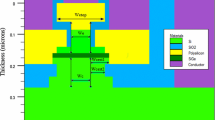Abstract
The modification of the emitter structure of silicon bipolar transistors results in more freedom in the choice between sometimes conflicting device parameters. The approach followed in this work is the use of an amorphous silicon (a-Si:H) or microcrystalline silicon (μc-Si) emitter, creating a real heterojunction with the crystalline silicon base. Due to the larger bandgap of these emitter materials, the back injection of minority carriers is strongly suppressed in comparison with conventional bipolar transistors. Furthermore, the small temperature coefficient of the current gainβ allows the use of these heterojunction bipolar transistors (HBT) over a wide temperature range. Most likely, the biggest advantage of such HBTs is that a better high-frequency behaviour could be obtained. However, some problems still need to be solved such as the recombination at the emitter-base interface and the high resistivity of the emitter material.
Similar content being viewed by others
References
H.C. De Graaf: Solid St. Electr.10, 578 (1973)
T.H. Ning, R.D. Isaac: IEEE Trans. ED-27, 2051 (1980)
P. Ashburn, B. Soerowirdjo: IEEE Trans. ED-31, 853 (1984)
H.C. De Graaf, J.G. De Groot: IEEE Trans. ED-26, 1771 (1979)
M.A. Green, R.D. Godfrey: IEEE EDL-4, 225 (1983)
N. Oh-uchi, H. Hayashi, H. Yamoto, T. Matsushita: IEDM Technical Digest (1984) p. 746
E. Yablonovitch, T. Gmitter: IEEE EDL-6, 597 (1985)
M. Ghannam, J. Nijs, R. De Keersmaecker, R. Mertens: IEDM Techn. Digest (1984) p. 746
R.L. Anderson: Solid State Electr.5, 341 (1962)
H. Matsura, T. Okushi, K. Tanaka: J. Appl. Phys.55, 1012 (1984)
F. Evangelisti: J. Non-Cryst. Solids77 & w78, 969–978 (1985)
M. Cuniot, Y. Marfaing: J. Non-Cryst. Solids77 & 78, 987 (1985)
K. Sasaki, M. Rahman, S. Furukawa: IEEE EDL-6, 311 (1985)
H. Kroemer: Proc. IEEE70, 13 (1982)
H. Schade, Z.E. Smith: J. Appl. Phys.59, 1682 (1986)
A.R. Riben, D.L. Feucht: Int. J. Electronics20, 1359 (1966)
Y. Kanemitsu et al.: Jpn. J. Appl. Phys.25, 142–144 (1986)
J. Lindmayer, C.Y. Wringley:Fundamentals of semiconductor devices, Princeton, NJ (Van Nostrand 1966)
Author information
Authors and Affiliations
Additional information
On leave from University of Florida, Gainesville, Florida, USA
Rights and permissions
About this article
Cite this article
Symons, J., Ghannam, M., Nijs, J. et al. The use of amorphous and microcrystalline silicon for silicon heterojunction bipolar transistors. Appl. Phys. A 41, 291–295 (1986). https://doi.org/10.1007/BF00616051
Received:
Accepted:
Issue Date:
DOI: https://doi.org/10.1007/BF00616051




